 |
Convert MPEG to AWB
|
AMR MP3 Converter converts MPEG files to AWB format.
The software is an all in one audio converter that supports more than 90 audio
and video files as input, and converts to popular formats such as MP3, WAV, AAC,
M4A, OGG, WMA, and AWB.
AMR MP3 Converter also supports batch conversion, and is full compatible
with Vista and Windows
7.
- Free Download
AMR MP3 Converter here and then install the software
by instructions
- Launch AMR MP3 Converter
- Choose MPEG Files
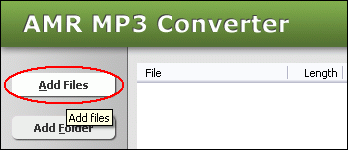
Click "Add Files" to choose MPEG files and then add them to conversion
list.
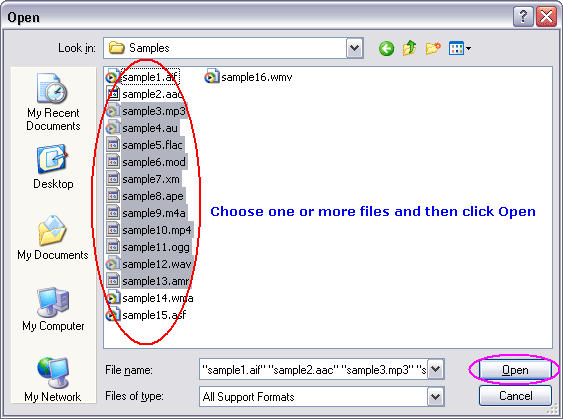
Choose one or more MPEG files you want to convert and then click Open.
- Choose "to AWB"
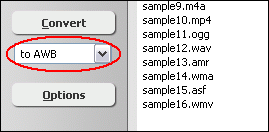
- Convert MPEG to AWB

Click button "Convert" to convert all MPEG files to AWB format.
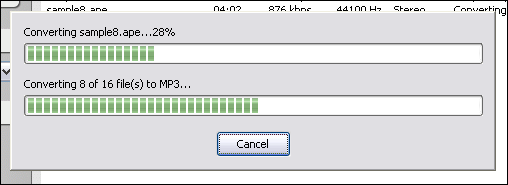
The software is converting MPEG files to AWB format.
- Play & Browse
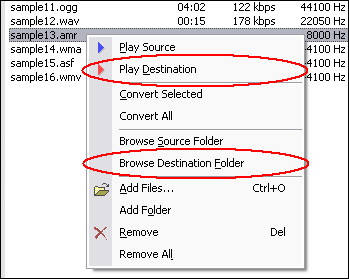
When conversion completes, you could right-click converted item and choose "Play
Destination" to play the destination file; or choose "Browse Destination
Folder" to open Windows Explorer to browse the destination file.
Top
What is MPEG?
The Moving Picture Experts Group (MPEG) was formed by the ISO to set standards
for audio and video compression and transmission. Its first meeting was in May
1988 in Ottawa, Canada. As of late 2005, MPEG has grown to include approximately
350 members per meeting from various industries, universities, and research institutions.
MPEG's official designation is ISO/IEC JTC1/SC29 WG11.
The MPEG standards consist of different Parts. Each part covers a certain aspect
of the whole specification. The standards also specify Profiles and Levels. Profiles
are intended to define a set of tools that are available, and Levels define the
range of appropriate values for the properties associated with them. MPEG has
standardized the following compression formats and ancillary standards:
- MPEG-1: The first compression standard for audio and video. It was
basically designed to allow moving pictures and sound to be encoded into the bitrate
of a Compact Disc. To meet the low bit requirement, MPEG-1 downsamples the images,
as well as uses picture rates of only 24-30 Hz, resulting in a moderate quality.
It includes the popular Layer 3 (MP3) audio compression format.
- MPEG-2: Transport, video and audio standards for broadcast-quality
television. MPEG-2 standard was considerably broader in scope and of wider appeal
- supporting interlacing and high definition. MPEG-2 is considered important because
it has been chosen as the compression scheme for over-the-air digital television
ATSC, DVB and ISDB, digital satellite TV services like Dish Network, digital cable
television signals, SVCD, and DVD.
- MPEG-3: Developments in standardizing scalable and multi-resolution
compression which would have become MPEG-3 were ready by the time MPEG-2 was to
be standardized; hence, these were incorporated into MPEG-2 and as a result there
is no MPEG-3 standard. MPEG-3 is not to be confused with MP3, which is MPEG-1
Audio Layer 3.
- MPEG-4: MPEG-4 uses further coding tools with additional complexity
to achieve higher compression factors than MPEG-2. In addition to more efficient
coding of video, MPEG-4 moves closer to computer graphics applications. In more
complex profiles, the MPEG-4 decoder effectively becomes a rendering processor
and the compressed bitstream describes three-dimensional shapes and surface texture.
MPEG-4 also provides Intellectual Property Management and Protection (IPMP) which
provides the facility to use proprietary technologies to manage and protect content
like digital rights management. Several new higher-efficiency video standards
(newer than MPEG-2 Video) are included (an alternative to MPEG-2 Video), notably:
- MPEG-4 Part 2 (or Simple and Advanced Simple Profile) and
- MPEG-4 AVC (or MPEG-4 Part 10 or H.264). MPEG-4 AVC may be used on
HD DVD and Blu-ray discs, along with VC-1 and MPEG-2.
In addition, the following standards, while not sequential advances to the
video encoding standard as with MPEG-1 through MPEG-4, are referred to by similar
notation:
- MPEG-7: A multimedia content description standard.
- MPEG-21: MPEG describes this standard as a multimedia framework.
Moreover, relatively more recently than other standards above, MPEG has started
following international standards; each of the standards holds multiple MPEG technologies
for a way of application. For example, MPEG-A includes a number of technologies
on multimedia application format.
- MPEG-A: Multimedia application format.
- MPEG-B: MPEG systems technologies.
- MPEG-C: MPEG video technologies.
- MPEG-D: MPEG audio technologies.
- MPEG-E: Multimedia Middleware.
What is AWB?
Adaptive Multi-Rate Wideband (AMR-WB) is a patented speech coding standard developed
based on Adaptive Multi-Rate encoding, using similar methodology as Algebraic
Code Excited Linear Prediction (ACELP). AMR-WB provides excellent speech quality
due to a wider speech bandwidth of 50-7000 Hz compared to narrowband speech coders
which in general are optimized for POTS wireline quality of 300-3400 Hz.
AMR-WB is codified as G.722.2, an ITU-T standard speech codec, formally known
as Wideband coding of speech at around 16 kbit/s using Adaptive Multi-Rate Wideband
(AMR-WB). G.722.2 AMR-WB is the same codec as the 3GPP AMR-WB. The corresponding
3GPP specifications are TS 26.190 for the speech codec and TS 26.194 for the Voice
Activity Detector.
A common file extension for AMR-WB file format is .awb. There also exists another
storage format for AMR-WB that is suitable for applications with more advanced
demands on the storage format, like random access or synchronization with video.
This format is the 3GPP-specified 3GP container format based on ISO base media
file format. 3GP also allows use of AMR-WB bit streams for stereo sound.
The AMR-WB bitrates are 6.60, 8.85, 12.65, 14.25, 15.85, 18.25, 19.85, 23.05
and 23.85 kbps. Compared to narrowband speech codecs (like AMR) optimized for
traditional telephone voice quality of 300-3400 Hz, the AMR-WB codec's wider bandwidth
of 50-7000 Hz provides excellent speech quality.
Convert MPEG to AWB Related Topics:
DIF to AWB,
IT to AWB,
HDTV to AWB,
M2A to AWB,
DVR-MS to AWB,
DVD to AWB,
4XM to AWB,
MP4 to AWB,
XVID to AWB,
M4A to AWB,
VMD to AWB,
SDP to AWB,
SND to AWB,
3G2 to AWB,
ULAW to AWB,
FLV to AWB,
VOC to AWB,
RPL to AWB,
MXF to AWB,
MPC to AWB,
MTM to AWB,
CAF to AWB,
F4B to AWB,
MTS to AWB,
FLAC to AWB,
VID to AWB,
AWB to M4B,
AC3 to AWB,
W64 to AWB,
EVOB to AWB,
MP1 to AWB,
WMV to AWB,
H263 to AWB,
SOL to AWB,
M4B to AWB,
ROQ to AWB,
MTV to AWB,
WM to AWB,
APE to AWB,
AWB to MP4
|






